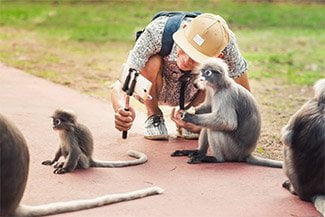Do monkeys show greater cognitive flexibility than humans?
 “We are a unique species and have various ways in which we are exceptionally different from every other creature on the planet […] But we're also sometimes really dumb.” What made Julia Watzek, the main author of the study described here, say this? Published in Scientific Reports, her research shows that, unlike apes, humans do not always consider alternative solutions to effectively solve problems. Let’s find out why.
“We are a unique species and have various ways in which we are exceptionally different from every other creature on the planet […] But we're also sometimes really dumb.” What made Julia Watzek, the main author of the study described here, say this? Published in Scientific Reports, her research shows that, unlike apes, humans do not always consider alternative solutions to effectively solve problems. Let’s find out why. In a predictable environment, we apply strategies (developed through past experiences) that save us from intense cognitive exertion and help us solve everyday problems. But we live in a changing environment, and alternative solutions are sometimes more appropriate than our usual go-to solutions. In the present study, the authors wanted to highlight the constraints of our cognitive system, which can prevent us from recognizing that a familiar strategy is no longer effective, and that a new, more beneficial one should be considered. When it comes to this type of cognitive flexibility, Julia Watzek and her colleagues indicate that it may vary by culture. For example, Western education seems to reinforce the association of a single correct answer to any given problem.
Testing the presence of cognitive inflexibility in other animal species is a good way to get a better understanding of the subject. To carry out the study, the researchers simplified a protocol developed for a 2015 study by Sarah M. Pope and colleagues to make it less dependent on working memory.
60 students from Georgia State University (50 women, 10 men; average age = 19.8 years) and 22 Capuchin monkeys (16 females, 6 males, average age = 16.09 years) and 7 resus monkeys (all males, average age = 21 years) were recruited to participate in the following experimental protocol. During the first phase of training, the subjects saw a striped square (square 1) and a dotted square (square 2) and were rewarded for selecting square 1 followed by square 2. In the second phase of training, the scientists increased the number of possible responses by presenting two empty squares in addition to squares 1 and 2. In the final phase, once the participants had selected squares 1 and 2, a blue triangle appeared, replacing the two empty squares. The participants received a reward when they selected this triangle (thanks to a learned strategy: square 1 ? square 2 ? triangle): a congratulatory jingle for the humans, and a banana pellet for the animals. If the participants responded incorrectly, they received a short timeout and no reward. Once the process had been learned, the research team modified the configuration in the next session by presenting screens where the triangle option was shown directly (without the first two steps with the squares).
So how did the different participants react? While all the monkeys (Capuchins and Rhesus macaques) quickly took the shortcut (immediately selecting the triangle), 61% of humans (56 people at this stage of the protocol, as 4 didn’t pass the initial training) didn’t. Note that as soon as the “simplified” screen appeared, 70% of the monkeys opted for the alternative solution rather than the previously learned solution. Only one of the adult humans dared to take the shortcut! Some of the participants from each species also used an intermediary strategy: they began by using the learned rule, but switched to the shortcut after selecting the first square.
The research suggest that monkeys show greater cognitive flexibility than humans, as they are more likely to consider a new strategy when confronted with a new context. The authors of the study suggest that differences in working memory capabilities could influence the use of the learned strategy. According to them, a limited working memory capacity may promote the use of a shortcut. They also call into question our culture of rote learning, which may lead us to make inefficient decisions and potentially miss opportunities.
On a positive note, the scientists specify that: “More of the humans do take the shortcut after seeing a video of somebody taking the shortcut, but about 30 percent still don't.” In another version of the experiment, the humans were told that they should not be afraid to try new things. While more participants took the shortcut, many continued with their old habits.
Source: Julia Watzek, Sarah M. Pope, Sarah F. Brosnan. “Capuchin and rhesus monkeys but not humans show cognitive flexibility in an optional-switch task”. Scientific Reports, Sept. 2019 // Pope, S. M., Meguerditchian, A., Hopkins, W. D. & Fagot, J. Baboons (Papio papio), but not humans, break cognitive set in a visuomotor task. Anim. Cogn. 18, 1339–1346 (2015)







